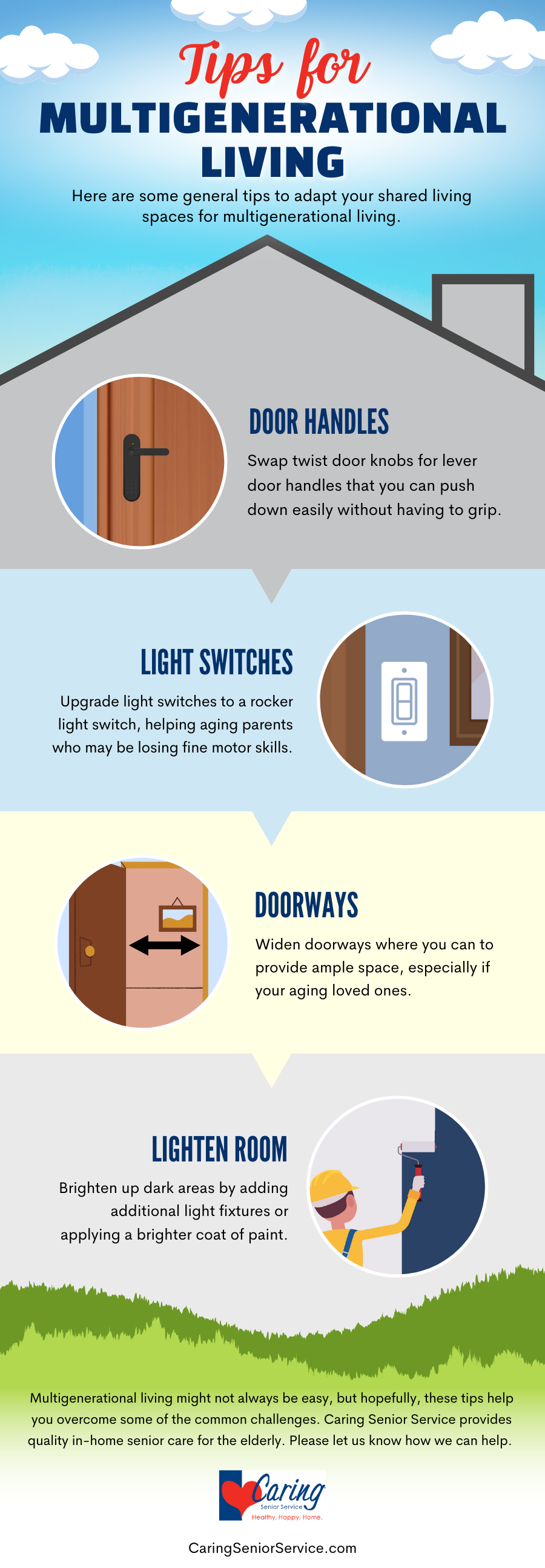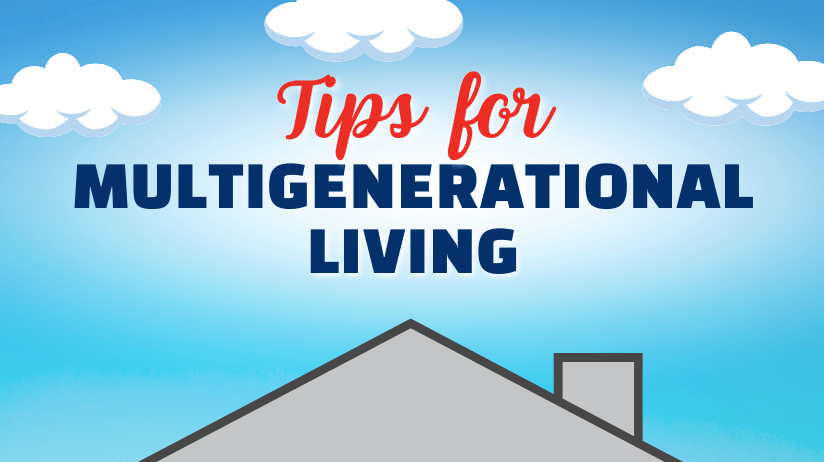For families across the United States are embracing multigenerational living. Bringing multiple generations under one roof can boast multiple benefits, including enhanced family bonds and the ease of caring for aging loved ones. While most homes are built for single families, there are many ways you can easily adapt your living situation to make multigenerational spaces safe and comfortable for everyone.
Check out the infographic below for some quick tips. Explore additional tips for multigenerational living in our full post below.

Share this Image On Your Site
Start with a Shared Vision
To successfully live in a multigenerational home, family members have to be on the same page. It all starts with open communication and a shared vision among all family members. Before making any changes to the home, gather everyone for a discussion about expectations, boundaries, and responsibilities.
You should also discuss some of the unique needs and preferences of each family member — young kids, adult children, and older adults. While aging parents might need a helping hand now and then, they will likely want the ability to live as independently as possible. An open dialogue will ensure that everyone's needs and concerns are considered during the transition process.
Divide Spaces Thoughtfully
The layout of traditional single-family homes usually includes a master bedroom and bathroom with smaller bedrooms for kids and guests. But this layout isn’t always conducive to multigenerational living. You may need to consider changing the layout of your home, converting your garage into an extra room, finishing the basement, adding an addition to the home, or even giving up your master suite when living with multiple generations.
As you divide up different areas of the home, it’s also important to balance privacy with togetherness. Everyone will need their alone time. So, try incorporating spaces where family members can go to relax and be alone, like a reading room or second living room. But you’ll also need communal spaces that everyone can enjoy, like a dining room, living room, or outdoor patio.
Make Adjustments to Shared Living Spaces
Because family members of all ages will be living in a multigenerational house, it’s important to make adjustments to support the safety and comfort of aging loved ones. Here are some general tips to keep in mind throughout the house as you adapt your living arrangements.
- Swap twist door knobs for lever door handles that you can push down easily without having to grip.
- Upgrade light switches to a rocker light switch, helping aging parents who may be losing fine motor skills.
- Widen doorways where you can to provide ample space, especially if your aging loved ones.
- Brighten up dark areas by adding additional light fixtures or applying a brighter coat of paint.
Now that you have a general idea of some renovations to make to accommodate adult generations, let's take a look at commonly shared spaces in the home and discover how you can adapt each area.
Bathroom
The bathroom is one of the main shared spaces that everyone will need to use. Consider making these small renovations to your bathroom to make it safer for older adults.
- Install grab rails by the toilet and shower to help reduce the risk of falls.
- Replace traditional tub and shower combo with a walk-in shower. Add a small shower chair for additional safety.
- Swap the shower head for one that has handheld capabilities, making showering easier for adults with restricted mobility.
Kitchen
The kitchen is often the heart of a home. It can be a beautiful experience when family members of different generations come together to prepare a meal. Here are some tips to accommodate multiple generations in the same home.
- Devote some storage space in cabinets, the pantry, and even the fridge to your loved ones, so that they have some space of their own.
- Install under-cabinet lighting to make sure countertop surfaces in the kitchen are well lit for meal prep.
- Swap out cabinet hardware with drawer pulls or cabinet grips that don’t require a tight grip.
Living Room
The living room is where many family members will go to socialize. So, it should be comfortable enough to accommodate everyone while also safe. Here are some considerations to adapt your living room.
- Reduce excess furniture that limits walkways or could become a fall hazard.
- Upgrade your sofa to a sectional that can seat more people. Multi-piece furniture sets look great, but they can impede open spaces and create dangerous narrow walkways.
- Consider the different uses for the living room and try to accommodate everyone’s needs. For example, you might have an area with kids’ toys and a corner for grandparents to sit and read.
Consider All Design Preferences
Not everyone has the same design taste. But if you and your family members will be living together, it’s important that everyone can appreciate shared spaces. Imagine if you moved into a family member’s home, and they didn’t let you put up any of your pictures or didn’t want to use any of your furniture. It really wouldn’t feel like your space too.
Here are some tips for blending different design styles.
- Keep shared spaces, like the living room, free from clutter. Maintain wide walkways for safety.
- Allow individuals to express their creativity and unique design style in their private spaces.
- When buying new furniture, get input from different family members.
- Include pictures, wall art, and even furniture that belongs to other family members to help the space feel more inclusive.
- Use contrasting colors to help older adults with visual impairments. For example, paint the door a different color than the wall.
Embracing multigenerational living might not always be easy, but hopefully these tips help you overcome some of the common challenges of living under the same roof. Remember, a thoughtful approach and a good design can help family members come together for a smooth transition. We’d love to hear how your family has adapted to multigenerational living!

